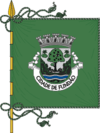Fundão, Portugal
| Fundão | |||
|---|---|---|---|
| Municipality | |||
| |||
 | |||
| Coordinates: 40°08′N 7°30′W / 40.133°N 7.500°WCoordinates: 40°08′N 7°30′W / 40.133°N 7.500°W | |||
| Country |
| ||
| Region | Centro | ||
| Subregion | Cova da Beira | ||
| Intermunic. comm. | Beiras e Serra da Estrela | ||
| District | Castelo Branco | ||
| Parishes | 23 | ||
| Government | |||
| • President | [Paulo Fernandes] (PSD) | ||
| Area | |||
| • Total | 700.20 km2 (270.35 sq mi) | ||
| Population (2011) | |||
| • Total | 29,213 | ||
| • Density | 42/km2 (110/sq mi) | ||
| Time zone | WET/WEST (UTC+0/+1) | ||
| Website | http://www.cm-fundao.pt | ||
Fundão (Portuguese pronunciation: [fũˈdɐ̃w]) is a city and a municipality in the Castelo Branco District in Portugal. Fundão proper is an old city with 8,369 inhabitants in 2001,[1] situated at the point where the slope of the Gardunha range meets the Cova da Beira plains, 500 metres above sea level. The municipality population in 2011 was 29,213,[2] in an area of 700.20 km².[3] It is subdivided in 23 parishes. The film festival, IMAGO – Young Film and Video Festival, is organised in the town.[4]
History
During the Iron Age, from about 1000 B.C. until its destruction by the Romans, there was a Celtic Lusitanian Castro or fortified village in nearby São Brás Mount. The remains of a villa or agricultural manor house, workers houses and other associated buildings from the time of the Roman Empire have been found in the underground of the centre of the current city. This villa was rebuilt as a fortified medieval mansion during the High Middle Ages.
The history of Fundão is intimately related to that of its originally Jewish, then New Christian or Marrano, population.
Although the place was already mentioned in documents from 1307 referring 32 houses, the bulk of the population only settled after the 1492 Expulsion of the Jews from Spain by Ferdinand and Isabella, mainly Spanish Jews (sephardic). Close to the border, and already home to significant Jewish minorities the Cova da Beira region, the region received many refugees. They settled in the community of Fundão, which their numbers swelled to that of a city. The influx of Jewish artisans and merchants quickly transformed it into an important commercial and industrial center. With the establishment of the Portuguese Inquisition shortly thereafter, many Jews and New Christians were arrested, tortured, executed or had their possessions expropriated. The commercial dynamism of the city was affected.
The place was proclaimed a city in 1580 by its notables, after support for their attempt was declared by Dom António, Prior do Crato, to preserve Portuguese independence against the ambitions of King Philip II of Spain (Philip I of Portugal). The Municipal Council and autonomy were granted in 1747.
Under the Enlightenment of the late 18th century the Prime-Minister of Portugal, the Marquis of Pombal, legal restraints on the New Christians were abolished and rights equiparated to those of the Old Christians. Pombal tried to recreate the industrial preëminence of Fundão by founding the Royal Factories (today the City Hall). These efforts allowed a measure of revival to the wool industries of the city, and cloth was again exported to northern Europe. The city decayed again after its sack during the (defeated) Napoleonic French invasions of Portugal, and the following Civil War between supporters of the Liberal Constitutionalist D. Pedro and his brother Conservative Absolutist D. Miguel for the throne.
Parishes
Administratively, the municipality is divided into 23 civil parishes (freguesias):[5]
- Alcaide
- Alcaria
- Alcongosta
- Alpedrinha
- Barroca
- Bogas de Cima
- Capinha
- Castelejo
- Castelo Novo
- Enxames
- Fatela
- Fundão, Valverde, Donas, Aldeia de Joanes e Aldeia Nova do Cabo
- Janeiro de Cima e Bogas de Baixo
- Lavacolhos
- Orca
- Pêro Viseu
- Póvoa de Atalaia e Atalaia do Campo
- Silvares
- Soalheira
- Souto da Casa
- Telhado
- Três Povos
- Vale de Prazeres e Mata da Rainha
Economy
The town is an important local center of industry and services. Around it lies some of the most fertile land in the region, in a large valley (Cova da Beira) between the Gardunha and Estrela ranges, where the Zêzere River starts its way towards the Tagus. The most significant productions are cherries, peaches, olive oil, wine, wood pulp and vegetables.
Some of the most important wolframite mines in the world (a mineral source for the element tungsten) are explored within its municipal limits. Other important mines extract lead and tin. High quality mineral water is bottled from several sources.
The Cavleiro tree is a common trade item from this region. It is used in everyday products such as wooden dolls, shoes and bedposts.
References
- ↑ UMA POPULAÇÃO QUE SE URBANIZA, Uma avaliação recente - Cidades, 2004 Archived October 6, 2014, at the Wayback Machine. Nuno Pires Soares, Instituto Geográfico Português (Geographic Institute of Portugal)
- ↑ Instituto Nacional de Estatística
- ↑ Direção-Geral do Território
- ↑ IMAGO – Young Film and Video Festival
- ↑ Diário da República. "Law nr. 11-A/2013, page 552 52" (pdf) (in Portuguese). Retrieved 23 July 2014.
External links
| Wikimedia Commons has media related to Fundão. |

